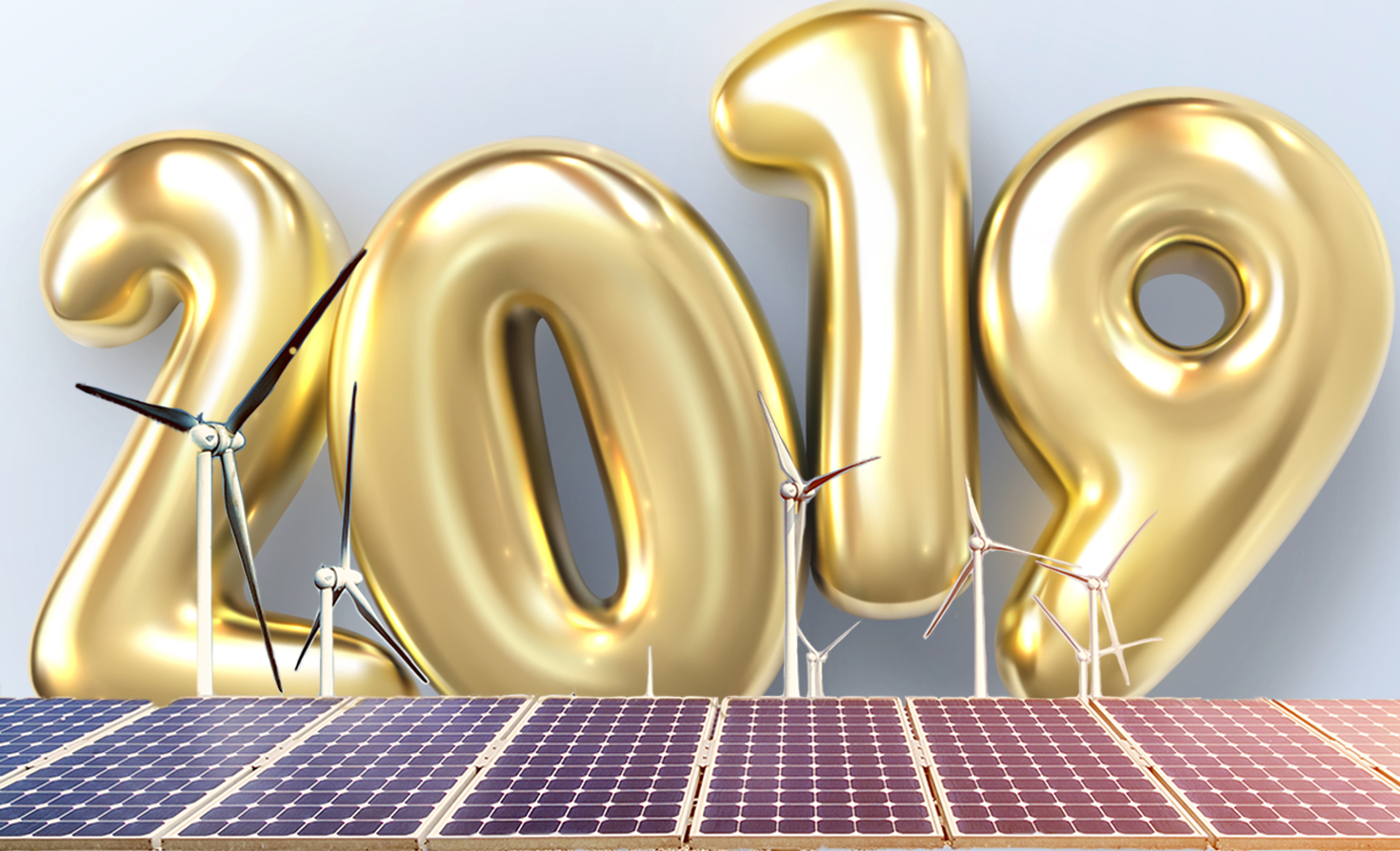In my mind, year-ahead predictions by journalists like me are somewhat akin to corporate sustainability commitments — the best are aspirational, yet grounded in some practical reality. Some are hopeful, others resigned. With that, here are some thoughts crowding my brain on the precipice of this new year.
1. Anticipate more creativity in corporate clean power deals. 2018 was a blockbuster for renewable energy contracts made possible by businesses intent on pushing fossil fuels off the electricity grid.
As of Dec. 14, the capacity added over the past 12 months that was directly attributable to power purchase agreements, green tariff programs and other investments by corporate energy buyers reached a record 6.43 gigawatts, according to the data trackers at the Rocky Mountain Institute’s Business Renewables Center.
Coincidentally, another big deal was announced the day of that press release: a 100-megawatt virtual power purchase agreement (VPPA) by water tech and services company Ecolab for a Texas wind farm.
I have every confidence that 2019 will bring more massive deals of this nature, although I believe those projects won’t necessarily be in the United States. Personally speaking, I’m interested in the next tier of investments, deals that look more like Organic Valley’s community solar projectportfolio, or that see big companies casting themselves in the role of power producers.
An example of what I mean is the renewable natural gas joint venture that Smithfield Farms is forming with Dominion Energy. Together, the two companies plan to invest $250 million in technology that will capture methane emissions from hog farms and convert it into gas.
2. Expect more municipal renewable energy moves. Just before Christmas, the city of Philadelphia forged a 20-year, 70 MW deal for a solar farm that will power its government facilities. The contract is estimated to eliminate about 4 million tons of carbon dioxide (CO2) emissions over its lifetime. What’s more, there’s an associated economic development plan that will enable minority-, disabled- and women-owned businesses to participate.
Given the number of U.S. cities that have committed to sourcing their power 100 percent from renewables (102 and counting), it’s a pretty safe bet that more cities will step forward like this over the next 12 months.
One project to watch for in particular: the multi-city project spearheaded by the city of Boston. Last summer, the 20 cities involved in this — representing an aggregate energy load of 5.7 terawatt-hours — issued a request for information for projects that could meet their needs. That information was due at the end of August. Stay tuned.
3. The nuclear industry will give us plenty to talk about. Much has been made of Xcel Energy’s industry-leading commitment to “carbon free” energy — it is the first U.S. utility to make such a declaration. But you’ll notice an adjective that isn’t in that pledge: renewable.
Xcel has made no secret of the fact that nuclear technologies will be foundational and critical in the upcoming transition. In fact, two nuclear plants provide almost 30 percent of the electricity it generates in the Upper Midwest.
The Department of Energy also has keyed in on nuclear as an “increasingly important” ingredient of the company mix — Secretary Rick Perry has proposed subsidies for aging plants, in the name of resilience and national security. In November, the agency committed $18 million more in research and development funding to a series of advanced nuclear projects. What’s more, a number of states are stepping up to support their nuclear infrastructure, including New Jersey, Connecticut, Illinois and New York.
And, nuclear-fusion startups (the holy grail of clean energy) are drawing some pretty high-profile investors, including Breakthrough Energy, a coalition that includes billionaire backers Marc Benioff, Jeff Bezos, Richard Branson, Bill Gates, Jack Ma and Meg Whitman.
BTW, for a great essay about the role of nuclear in a carbon-free grid, read this piece by Vox’s David Roberts. The big takeaway is that nuclear isn’t going away.
4. More utilities will buy into the potential of distributed generation. If you can’t beat them, join them. Most commercial microgrids that have been lit up over the past two years in the United States were championed by commercial and industrial enthusiasts, many of which had to work around their local utility in order to make their plan a reality.
Slowly but surely, that’s changing, as reported in this week’s featured article by Navigant analyst Peter Asmus. Utilities — notably Duke Energy (and Consolidated Edison as evidenced by its work with Bloom Energy) — are waking up to the reality that investments in distributed energy and storage at the community scale can, at the very least, help them counteract the expense of massive, central power plant investments. Call it part of the transition plan.
5. More oil companies will proclaim themselves renewables champions. $4 billion. That’s the amount of money Shell plans to invest annually in “green energy,” according to an interview published Christmas day by The Guardian.
That number pales in comparison with the more than $20 billion it will continue to put into oil and gas operations every year. But it’s part of a trend. In the past two months alone, Shell became part of an offshore wind venture (with EDF Renewables) and launched an energy efficiency servicecalled Shell Energy Inside (along with cleantech startups Sparkfund and Gridpoint).
And then there’s ExxonMobil, which ranked in the top five this year when it comes to corporate PPAs for renewable energy. It has signed up to procure a combined 500 MW in wind and solar energy over the next 12 years from Lincoln Clean Energy (now part of Orsted).
6. Overlook action in rural communities at your peril. One thing businesses cannot afford to do in 2019 is ignore the issue of equity or location when making investments in renewable energy projects. Something most appealing to me about the recent Organic Valley community solar deal was that it brought clean electricity to places that some massive contracts don’t typically reach, such as communities in Wisconsin.
One of the bigger federal-level victories for the clean energy movement in 2018 was that the USDA’s Rural Energy for American Program, which gives farmers credit for investments in things such as solar, biomass, geothermal and small hydro. It survived the Trump administration clean energy budget butchers.
You also might be surprised to learn that wind farm leases generate at least $245 million annually for farmers and ranchers, according to a report by the Natural Resources Defense Council. Rural electric cooperatives have been particularly adept at navigating community solar programs: more than 190 co-ops offer community solar in 31 states.
All of this points back to something we should all do a better job of remembering: The corporate sustainability community needs to do a better job of finding and backing clean energy investments that benefit everyone, not just a small portion of the country or those with enough disposable income to buy into elite programs.
7. Lithium-ion batteries won’t be the only storage game in town. There’s every reason to believe that investments in energy storage installations — both utility-scale and behind-the-meter systems — will continue to add up appreciably this year. China just approved its first big project.
While cost reductions and the density increases for lithium-ion technologies will make that format the bulk of the attention for commercial and industrial projects, don’t discount emerging thermal approaches. Exhibit A: Early-stage startup Malta, just spun out of Google’s parent company, Alphabet.
The company, which has received $16 million in Series A funding from investors including the aforementioned Breakthrough Energy, is working on technology that will store electricity as either heat in molten sale or cold in antifreeze liquid. When I spoke with Malta CEO Ramya Swaminathan before the holiday, she told me the first demonstration system probably will have a capacity of 10 MW.
The upside: This will be a long-duration technology that can store electricity for between eight and 20 hours. The downside: Installations will need space, which means they won’t be sited in dense urban locations.
Incidentally, the total molten salt thermal market in 2017 was valued at around $9 billion (the U.S. share was $6 billion). It could expand to more than $55 billion by 2024, according to a recent prediction.
Enough pontificating. I wish you and yours a very happy, healthy and hopeful 2019.
This article is drawn from the Energy Weekly newsletter produced by GreenBiz.com, running Thursdays. Subscribe here.




